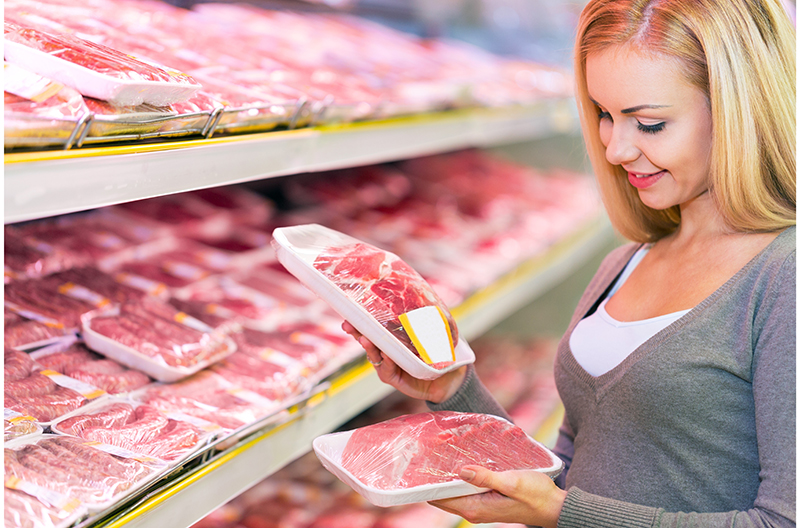Following last year’s virtual presentation, the “Power of Meat 2023: An In-Depth Look At The Meat Department Through The Shoppers’ Eyes” came back stronger than ever this year during the Annual Meat Conference in Dallas, Texas.
Led by Anne-Marie Roerink, principal and founder of 210 Analytics, the presentation was held yesterday as the conference’s first general session. Roerink presided over the company’s findings in a joint survey with FMI – The Food Industry Association that spotlighted today’s economic uncertainty, supply chain disruption and continuing trends within the meat industry post-pandemic.
“The Power of Meat reflects on another unusual year,” Roerink said. “Of course, we all know that in ‘22, the headlines were taken by inflation, not just in our category but really every category in grocery shopping and life altogether. All in all, the meat department had an increase in prices of eight-and-a-half percent.”
But increasing prices are not keeping customers away. They are spending on average “25 percent more” on food and beverages today than they did prior to the pandemic, Roerink said. The department has continued to grow. In 2022, meat saw half a percent of growth in pounds compared to the same period in 2021.
“We continue to do extremely well, and the demand for meat continues to be very strong,” Roerink said.
According to the survey and written report compiled by 210 Analytics and FMI, the meat category saw $87.1 billion in annual sales, with 98.3 percent household penetration. It remains the most powerful of the perimeter departments, Roerink said during the presentation.
Beef continues to be the highest performing fresh meat, specifically ground, and chicken and ground turkey have seen increased dividends while bacon and pre-packaged lunchmeat are the highest performing processed meats. Conversely, more niche areas such as lamb and bison continue to see decreases.
Roerink noted that these smaller categories jumped “tremendously” during the pandemic, so the decrease in overall volume is most likely due to the sales moving back toward pre-pandemic levels while being further hindered by rising costs.
Inflation continues to be the focal point on many consumers’ minds. Roerink said it lends to the popularity of ground beef and turkey.
“We’ve seen a lot of innovation when it comes to ground (meats). If you think about it, ground is a wonderful way for the consumer to try something different without putting their dollar in a whole lot of risk. ‘I don’t know what to do with it’ doesn’t matter all that much, because you can always do something with it and it continues to be the best price point,” she said.
In overall behaviors, inflation is keeping families cooking at home and out of restaurants, something which experts predicted would not be the case following the pandemic. Trends also show that consumers are becoming less dedicated to one specific retailer, as shopping around for prices and going to supercenters, wholesale clubs and online outlets become more popular.
“More people bought meat and poultry online and bought it more frequently. Meat and poultry prices, quality and reputation decide where people buy most of their meat and poultry. A strong meat department reputation is driven by freshness and quality of the product itself, a clean and well-stocked department with good prices and service excellence,” the report reads.
Roerink said that 76 percent of Americans are “making changes to how and what they buy when shopping for groceries.”
She also shared statistics stating that 71 percent of shoppers are eating out less in an effort to save money. That number has continued to drop over the past two years. At the height of the pandemic, 88 percent of Americans preferred to make meals at home, while last year that number sat at around 78 percent.
“But as inflation took hold, we saw more meals move back to the home. That is breakfast, lunch and dinner,” she said.
The biggest thing that is keeping consumers going back to restaurants is time. Consumers continue to avoid cooking when they are “smack out of time” to get dinner on the table, they just aren’t in the mood to cook or a special occasion can “win the dollar,” Roerink said.
The sentiment around meat continues to be strong, but emerging trends and lifestyle choices – along with increased prices and foodservice avenues – are driving dollars away from the meat counters. The majority of Americans consider themselves meat eaters and believe that meat and poultry belong in a healthy, balanced lifestyle, according to the study.
“Yet, 33 percent are actively trying to consume less meat and poultry, driven first and foremost by cost, followed by concerns over the healthfulness of eating red meat, the use of antibiotics, hormones and chemicals and the effect of animal agriculture on the planet. Those looking to reduce their consumption focus on portion size more than eating meatless meals,” the study said.
The study also suggests that less than 6 percent of meat eaters expect they will eliminate some or all meat or poultry this year.
For more information about the AMC show, visit meatconference.com.

